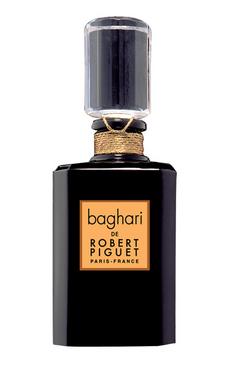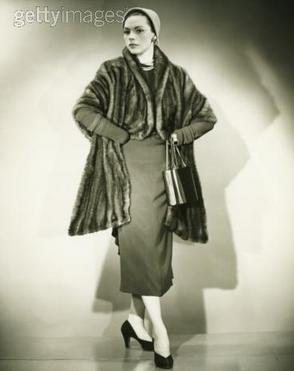Perfume Review & Musings: Baghari by Robert Piguet (The New & Vintage Versions)

The Piguet brand just released its re-edition of one of the classic scents from the catalogue of the former Parisian couture house of Robert Piguet following Bandit and Fracas. The original Baghari, named after the evocative name of an Indian town, was initially introduced in 1950, a year before the closure of the Piguet fashion house due to the designer's frail health. Piguet died two years later.
(The reformulated Baghari on the left in the parfum concentration).
I had acquired a small flacon of the vintage fragrance created by perfumer Francis Fabron in parfum concentration and was eager to compare it with the newer version in eau de parfum which was "rebalanced" by nose Aurélien Guichard of Givaudan. Judging from an advertisement I saw, the shape of my bottle is the same as one that was still commercialized around 1967.
Aurélien Guichard is also the author of Love in Paris by Nina Ricci, Les Belles-Cherry Fantasy by Nina Ricci, and Chinatown by Bond no 9. In 2005, the young Grasse-born perfumer was recognized by the Fashion Group International and named one of its Rising Stars.
The new Baghari is a lovely powdery and flowery concoction with discrete aldehydes giving it vibrancy. After the initial burst of fresh, aromatic notes it develops depth revealing a more sensual indolic heart where the jasmine rounds off the fragrance. A mix of slightly candied notes unfolds on a deeper sensual background composed of amber, vanilla, and musk. More austere woodsy notes such as vetiver, violet, and iris balance out the sweetness of the perfume. The drydown leaves a trail of powdery softness...
The scent's top notes are aldehydic notes, bergamot, neroli, violet. Heart notes are Rose Centifolia, Rose Damascena, jasmine, and orange blossom. Base notes are iris, vetiver, amber, vanilla, and modern musk.
Interestingly enough, the new Baghari version seems to derive its inspiration from another perfume of Francis Fabron, Le Dix by Balenciaga which was composed in 1947. It is as if Aurelien Guichard in his desire to remain faithful to the spirit of Fabron had sought inspiration in one of his softer fragrances to guide him in his task. Fabron is also the author of l'Air du Temps (1948).
The new Baghari is softer than the original Baghari, yet preserves the same overall characteritics, especially where the heart of floral notes is concerned. The top and base notes have been significantly modified. Another olfactory reference I find prominent in the new scent is a similarity with Je Reviens by Worth created in 1932 by Maurice Blanchet.
Smelling the new Baghari and the Je Reviens side by side the kinship becomes obvious but Je Reviens strikes me as being spicier making me think more of carnation and the floral notes also have greener undertones. The vetiver there is also stronger reinforcing the earthiness of the violet. The sweetness in Je Reviens is conveyed by the orange blossom while it is a sweet vanilla that predominates in the Piguet scent.
The Baghari edp has altogether a rounder body while the vintage edition has more "volume" as Edmond Roudnistka would put it. The reformulated Baghari is sweeter than the original as the natural earthiness and woodiness of the iris and violet come very much folded into the warm embrace of the vanilla and amber that are found in the base. The earthy and woody undercurrent, while present, never becomes obvious in the newer Baghari and remains implicit rather than explicit thanks to the use of a luscious warm amber and of a smaller quantity of vetiver. If I compare it to Le Dix by Balenciaga I find the same softness and woodiness of the violet and iris and the same powdery sillage. All these similarities can be felt but they are not defining and my first impression was that the new Baghari indeed smells distinctive. If the perfume is part of a tradition it is that of the vintage floral aldehydic scents which includes also Le Dix and Je Reviens.The drydown is gentle and powdery; the word that best describes it to me is "lovely". I would say that it is a slightly vintage romantic feminine perfume which hints at the image of a woman leaving behind her a perfumed wake created by luxurious powder and lipstick she uses.
How does it compare to the the 1950 version of Baghari? The new scent is prettier, lighter, and cleaner. It is also a much more polite version of its former self which, in my view, well reflects new social rules. It is striking in particular to me to see how the greater presence of women in the workforce and hence in public professional spaces has encouraged a movement of de-sexualization of women not only where the length of their hair or their sartorial code are concerned, but also, logically, where their perfumes are concerned. The notion of an office scent, that is, a perfume appropriate for the workplace has gelled quite a bit in people's mentalities. The contrast with the vintage version is thus obvious from the first instants. You could wear the new Baghari at the office, the vintage one would be riskier, more susceptible to offend people's sensitivities because it is anything but a self-effaced scent. In fact, they are so different in spirit that I find no strict parallelism, only an asymetry. One is potentially an office scent, the other a fur scent. The vintage Baghari parfum is much darker and animalic and has a hint of danger about it. I think that the Piguet perfumes all have that hint of danger about them. Bandit has been toned down and probably Fracas too but they were originally very much femmes fatales perfumes, real femmes fatales' perfumes. They smell like the test of truth of one's femininity.
It is what I feel with the vintage Baghari; there is something animal and feral about it yet very sophisticated at the same time. The aldehydes are very much the type you find in certain 1960s and 70s perfumes. That means that they emit an aroma reminiscent of tallow candle dominated by unabashed soapy undertones as in a slightly rancid soap which accentuate the animality and agressivity of the perfume. It is a much more self-centered fragrance in terms of its moral makeup. It engulfs you into an atmosphere that is anything but contemporary as one realizes that slightly disquieting animalic perfumes bordering on the offensive-smelling were thought to be seductive. And they are, perhaps too disquietingly so. They refer to a woman who has the instinct and natural strength of an animal and the sophistication of a lady. I wished I could find a picture to render this impression; the one below approximates it but is gentler and simpler than what I have in mind

I think that since fewer women worked in the 1950s in reaction to their mobilization during WWII, a current that pushed women to regain interest in more traditional feminine roles, a good number would be able to wear these more sexual scents in the comfort of their home or in social settings where seduction was encouraged. Women wore more furs too and this type of scent evokes the animality of a mink coat. It is a profoundly seductive perfume because it seems to want to please no one else but the wearer of the perfume first and foremost. It could almost smell bad to some and it is that lack of compromise that is truly interesting in my view. It is peppery and there is the very strong smell of a somber green accord that is both dissonant and harmonious. This accord smells somewhat of dusty old paper and mold, even camphor, perhaps teak wood and I am wondering if it's not labdanum. Until I get ahold of a few bottles of essential oils I will not be able to verify that. As the drydown progresses it smells more of a Russian leather accord with fatty undertones.
A social evolution is thus very much perceptible between the old Baghari and the new Baghari. The new perfume takes more into consideration the larger social circle of the wearer of the perfume wanting to be pleasant and well-behaved rather than advertise an in-your-face and provocative womanhood. While the old Baghari evokes an uber-sexual woman, I am tempted to say, a "real woman"(as in the ideal of a real woman), the new Baghari refuses to pursue a career of femme fatale but advocates instead a gentle, considerate femininity. The first one may disturb, the second one will reassure and make people feel comfortable. I could imagine women like Madonna and Cher wearing the vintage version while the newer version would be worn by Charlize Theron or Kirsten Dunst, in sum, actresses of the younger generation that either by temperament or for historical reasons need less to define themselves in relation or reaction to their amplified sexual power. So it is good news after all. The new Baghari is thus much more versatile and people who love soft powdery romantic perfumes with a lipstick feel to them will love it the most.
You can find the scent at all Neiman Marcus stores as well as Bergdoff Goodman in New York. For more information please go to the Piguet site.
Photos are from the press release and Getty Images.










An office scent or a fur scent? Which would I like more, let me think...The retro version wins, of course! :-) Thank you for the great review!
Hi Marina,
I bet it took you a long time to figure out which way you would go;) When I say an office scent, I mean a polite scent but this one being romantic would also be perfect for a date, especially a first one. In my teens when I experienced my powdery perfume period I was hunting down for this type of scent. They were rare in France and it was easier to come accross them in Great Britain or in the US. Certain French perfumes had a powdery formulation in the US that they didn't have in France for example or were sold exclusively in the US.
I sampled this one this am, and while it is truly lovely, it doesn't compare at all with your description of the original [which I've not smelled].
Clearly vintage would be the way to go, but I'm debating as to whether this might be a reasonable purchase... any suggestions, ladies?
Chaya,
Did you have an opportunity to try the extract for the new version? I haven't tried it myself and would be curious to compare it with the edp.
I bought mine on eBay. I wanted to add that although the old version is much more forceful, it is less long lasting than the new edp. More natural essences perhaps? Or old age?
Great review! Your ideas about the fact more women might be wearing fragrances in the office versus in more "seductive" environments were so insightful. I would love to try the vintage version; it sounds very intriguing.
Thank you Strange Accord. I think you have good chances of finding it on eBay. Let me know what you think when and if you get a chance to sniff it.
Thank you for a very helpful and insightful review,
it's thought provoking and informative.
I consistently feel illuminated by your blog.
Only have the reformulated edp myself,
but am quite taken with it.
Hope this finds you well.
Many thanks for your kind words. Wishing you the best too.